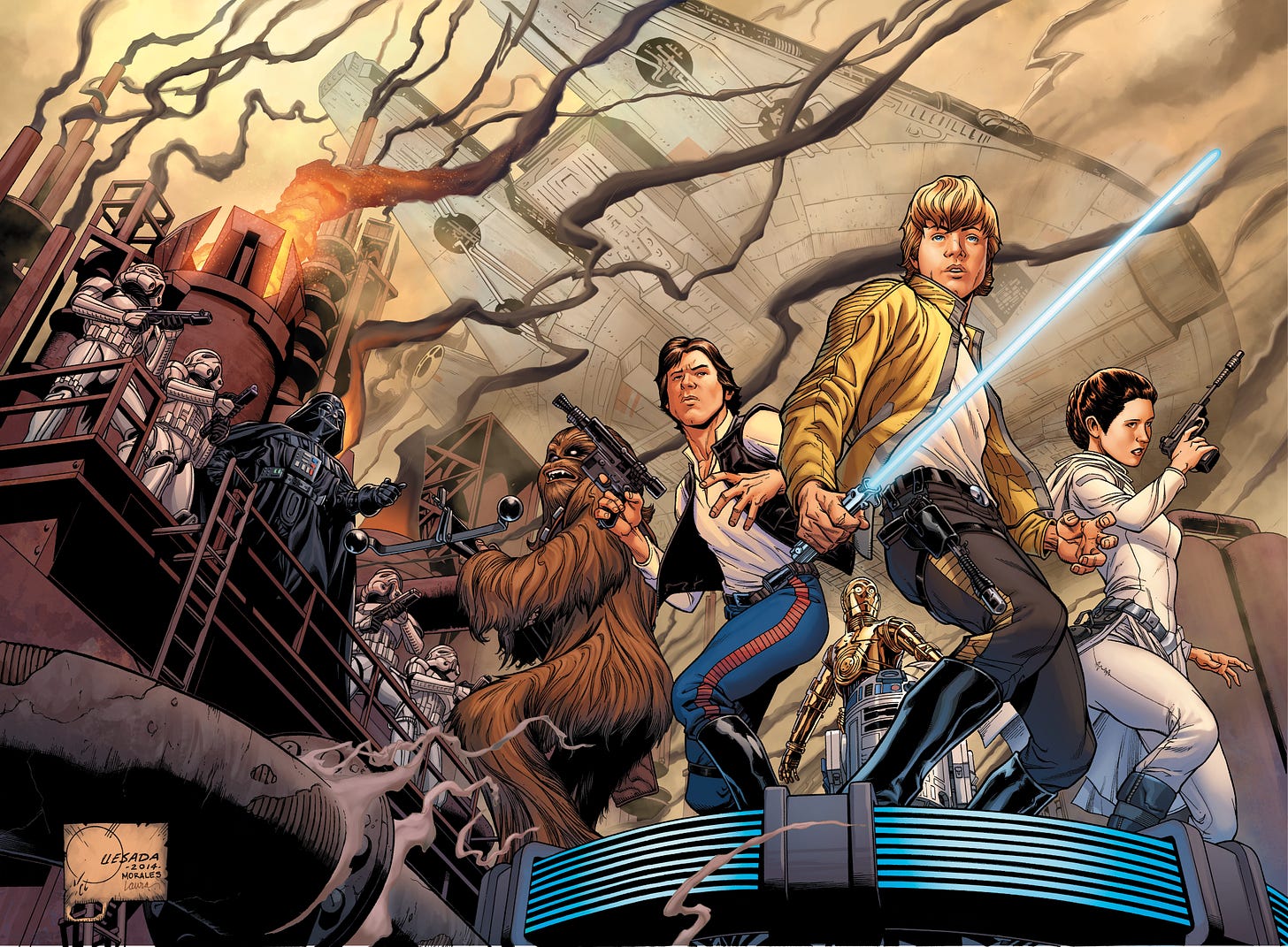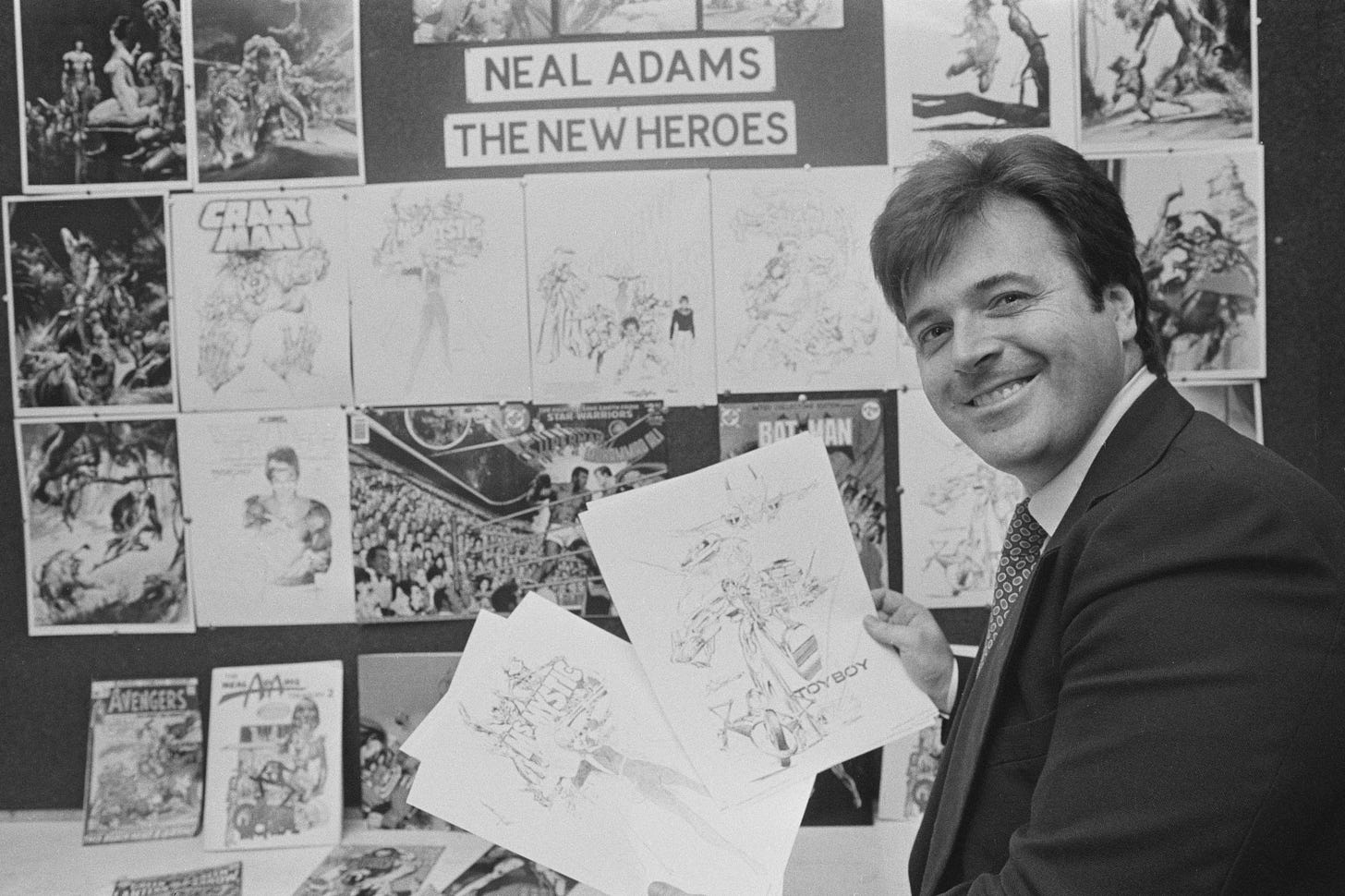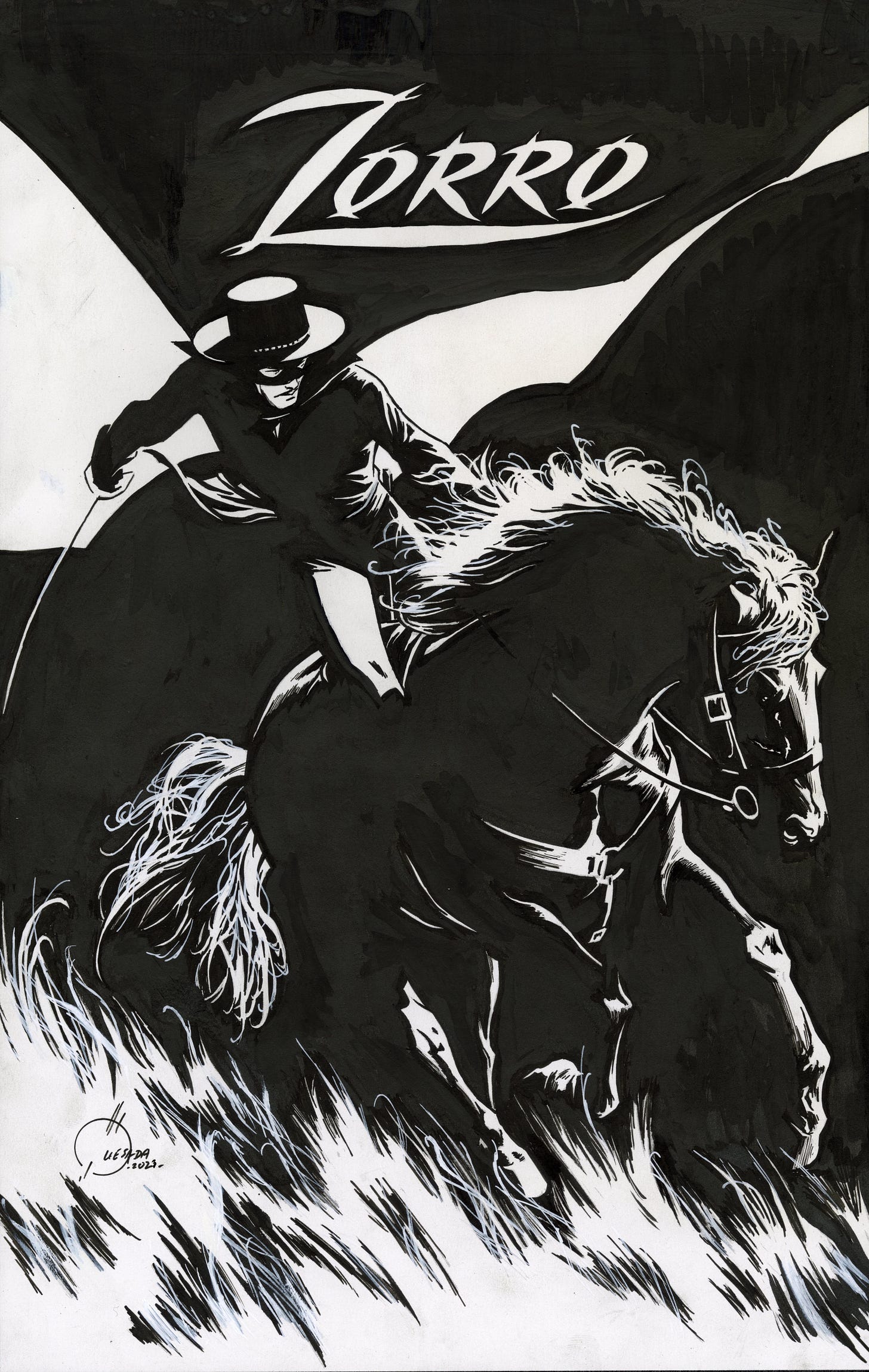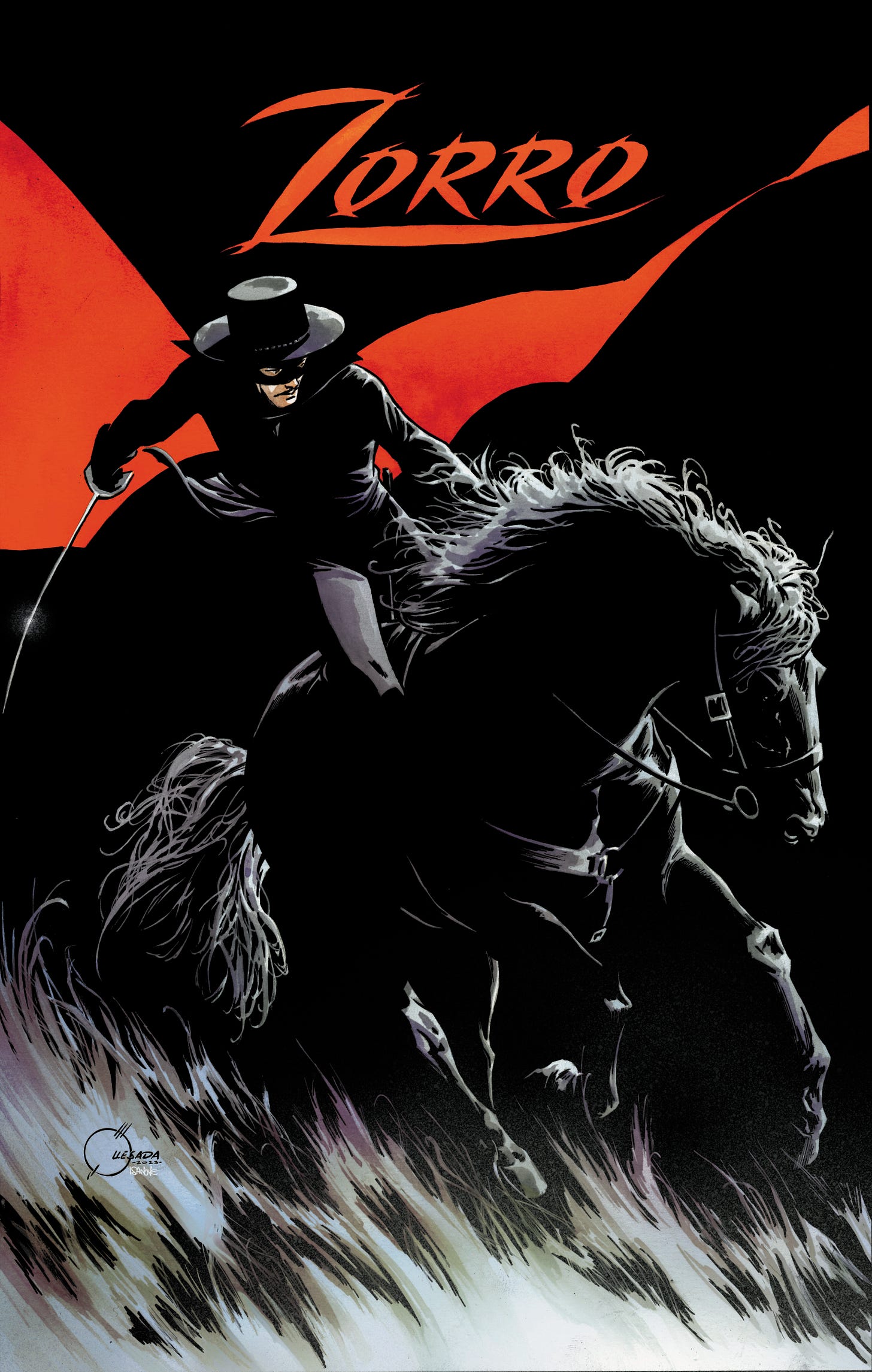Neal Adams And The Truth Behind Creating A Memorable Art Style
Never Meet Your Heroes Chapter 2: It's Not About What You Can Draw, It's About What You Can't
Pardon this short, self-promotional interruption.
S#!ts Gonna Get Real!
I hope I see you this week at New York Comic Con. You can find me on the show floor at my booth #3043. Seriously, I’ll be pissed if you’re at the show and don’t at least stop by to say hello.
Signing Times
Thursday: 11:00 am-1:00 pm and 4:00-6:00 pm
Friday: 12:00-2:00 pm and 4:00-6:00 pm
Saturday: 11:00 am-1:00 pm and 4:00-6:00 pm
Sunday: 11:00 am-1:00 pm and 3:00-4:00 pm
And on Friday, 10:30-11:30 am, in room 408, is the first-ever official New York Comic Con Drawing The Line Somewhere LIVE! panel.
Now that that’s out of the way…
DC Comics. Meh
In 1979, I was a senior at Newtown High School, putting together my portfolio in order to “audition” for art colleges. My art teacher, Ms. Lizzle, asked if I’d like to meet a professional art director who might be able to give me some valuable guidance. I jumped at the chance, and, like so many crazy coincidences in my life, this gentleman just happened to work at DC Comics.
At this time, I had zero interest in comics, having dropped them at 12 when I developed two new obsessions, baseball, and girls (and not necessarily in that order). So, this meeting at DC had little effect on me other than the fact that I would get some solid professional advice and a free pass to skip school for half a day.
I’m sure anyone my age who was a fan of comics would have stood slack-jawed at all of the graphics and posters on the wall, not to mention the living legends walking the halls at 75 Rockefeller Plaza. At the time, however, I was oblivious. I saw comics as a kid’s medium and not what I was interested in. What changed my outlook is a story for another newsletter. But yeah, I was a snob.
I’m not sure how Ms. Lizzle knew Jack Adler, but he couldn’t have been nicer and took considerable time out of his day to review my portfolio. Offering nothing but encouragement, I think he genuinely felt I had talent because as I packed up to leave, he said something I would never forget.
“Your art reminds me a lot of an artist I met when he was exactly your age: Neal Adams.”
The reason I would never forget isn’t because I walked out of the offices with a bloated and unearned self-importance, far from that. It was because of my response.
“Who’s Neal Adams?”1
After the initial shock wore off, Mr. Adler made me promise that I would come back to DC once I was done with my college studies. I never saw Mr. Adler again, and while it took a lot longer than four years… more like twenty-one, I did manage to keep that promise.
Late To The Party
In 1985, I was reintroduced to comics and became an avid weekly reader. In fact, comics rekindled my love for drawing, which I had lost right after college.2 I started to read back issues and collected editions because I had missed out on more than a decade’s worth of stories and art. When I finally came across Neal Adams' work, I instantly realized that Jack Adler had lied to me.
This Adams guy was one of the most gifted draftsmen ever to put pencil to paper, no less a comic book.
Years later, I was fortunate enough to meet Neal. His love for the medium was palpable. An entrepreneur and staunch fighter for creator’s rights, he also mentored some of the greatest artists in the modern era. He was always very kind to me and incredibly generous with his time when I would ask him to review my work. And, if you’re wondering, hell no, I never told him that Jack Adler story.
August 2000: I Was The Laughing Stock Of The Comics Industry
When I was named Marvel’s Editor in Chief, there were quite a few industry naysayers, many predicting that I would fail miserably and, hopefully, as comically as humanly possible. What does an artist with minimal editorial experience know about running a publishing division? Then, a few days after the announcement, I received a letter. It was from Neal congratulating me, telling me that I had “done good,” and offering up sage advice, all of which proved prophetic—especially the part about watching my weight. And, every once in a while, Neal would email me if he happened to like something I had recently drawn. Let me tell you, there’s no bigger boost to an artist’s confidence than getting an “atta boy” out of the blue from a legend.

I suspect he did this with a lot of artists, but I like to pretend it was just me.
Neal passed away unexpectedly on April 28, 2022.
Le Style C’est L’Homme
Neal once told me that an artist’s style can be directly attributed to the things we don’t know or understand how to draw. Unconsciously, we find creative workarounds by abstracting our weaknesses, and that, in turn, becomes our style. If not, we’d all be photorealists, and could you imagine anything more boring?
I’ve always found Neal’s theory interesting and think there’s a lot of truth to it.
Obviously, some do it better than others. That’s why certain artist’s styles resonate more with the audience.
And then there are those who try to fabricate a style or copy someone else's. These attempts often fail because the audience is smart enough to know it’s not genuine. I’m not referring to stylistic inspiration here. Every artist at the beginning of their career tries to emulate their idols. I tried my hardest to draw like Mike Mignola until I realized I’d never be that good and discovered who I was in the process. By the way, I found my own voice through an act of incredible generosity by Mike himself.3
I’ve thought about Neal’s theory quite often and added two addendums of my own.
1- Style can also come out of a need for expediency. It takes time to draw realistically.
2- For artists so brilliant that drawing photo-realistically comes more effortlessly than it does to others, their style evolves out of a need to push themselves beyond what’s visible. They begin to abstract in exciting ways. Sometimes, that takes the shape of minimalism, like Alex Toth, or wild imaginative techniques like Bill Sienkiewicz.
This idea of “style” has been top of mind for me lately.
Every project I’ve ever drawn or written has been a learning experience. Currently, I’m working on a massive story for Marvel that you’ll get to see sometime next year. From the onset, I decided that because of its epic scope and the writer I’m working with, it deserved a highly cinematic, realistic feel, and what I’m learning at the moment is that I will more than likely never attempt to draw something in this fashion again. Not because I’m not enjoying what I’m doing, but because it’s time-consuming, and I get bored of my $#it quickly.


These days, I find myself craving simplification, economy of line, and bolder light sources. To draw what’s necessary, not what’s there. I’ve been looking more and more at the works of Alex Raymond, Toth, Milton Caniff, Paul Martin, David Mazzucchelli, and John Paul Leon. You might have even noticed hints of these influences in some of my recent cover work.
But here’s the thing: Distilling an image into what’s absolutely necessary takes a lot of skill, confidence, and courage. Why courage? Let me give you a little insight into this artist’s mind and the doubts that creep in late at night when no one can see me crying at the drafting table.
Will you want to take this journey with me? Will you find my change in gears appealing, or will you write in and say, “I don’t know? It’s okay, but I preferred your old stuff better.”
I guess we’ll find out together.
In the meantime, what do you think about Neal’s theory? I’m always open to hearing other points of view. You know what, this sounds like a good question for my buddy, a prince among men and gentlemen philosopher Howard Chaykin. Maybe someday he’ll agree to slum it and let me interview him.
Less Is… Hard
The piece below is for the brilliant Sean Gordon Murphy’s Zorro Kickstarter campaign. It’s inspired by my love of Toth and was a challenging piece for me to accomplish.
It wasn’t the composition, the figure drawing, or the horse; it was trusting that everything I needed was already on the page and knowing when to stop when every cell in my body wanted to go back and render textures and model the form.
I’m hoping in the future, I’ll be able to continue resisting that impulse and maybe do a little less crying at the drafting table at night.
Thanks for reading.
You’re Amazing!
JQ
This is how much I love you. I cringe every time I tell this story.
I promise I’ll get to all of these stories in future newsletters.
Yup, yet another story for another day.







As noted, despite his often deranged and cockeyed perspective, Neal was on to something with this. I have always felt that the best of us make assets of our liabilities. This is certainly true of me.
A,
I'm glad you're enjoying the newsletter. This is why I love Substack, everyone here wants to be here and it makes writing these stories and updates much more fun than throwing them into the great void that is most of social media.
FYI: I'll only excuse the "Sir" stuff once, it's Joe ;^). Chaykin however is always "The Great."